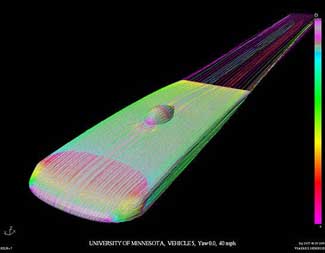The Car: Development of Borealis 2
Borealis 2 will be the University of Minnesota's 6th generation solar vehicle. The design of Borealis 2 began in the fall of 2002 with the goal being the evolution of the Borealis car design. All the systems on the revolutionary Borealis car were examined and their effectiveness considered. Reliability and efficiency are two of the major goals as the components that will make up Borealis 2 are designed.
Mechanical Team to Prioritize Reliability
The mechanical team, led by co-leaders Jason Halpern and Travis Lee, intends to continue the tradition of the solar vehicle project and refine the technology exhibited in Borealis to new levels in Borealis II. The mechanical team will be focusing on refining the current vehicles systems to achieve a new standard of reliability, quality and maintainability. The team is conducting rigorous investigations into suspension and steering geometry, which promise to increase the efficiency of Borealis II's mechanical system. Further refinements to the steering, brakes, and suspension will reduce weight, increase manufacturability and ease maintenance tasks. The mechanical team is also paying keen attention to driver safety in Borealis II through the redesign of the roll cage and driver compartment. The overall stability of Borealis II will be enhanced with careful changes to component placement for better weight distribution. Weight is, of course, the enemy of efficiency in solar car design and the mechanical team remains dedicated to significant weight reduction in the design of Borealis II through the use of composites and other design features.
Aero Team Aims to Improve Beyond Borealis
While the design of Borealis was a drastic change over the previous four U of M solar cars, strongly favoring aerodynamics, the new Aerodynamics Team has already found more ways to increase the aerodynamic performance for Borealis II. Team leaders Drew Klaphake, Matt Thomasson, and Ryan Halsch are working closely with the Array Team to improve both the aerodynamics and array area. They acquired a new Computational Fluid Dynamics package to help achieve an improved design through computer simulations. Team members are also looking into the use of less complex and lighter wheel fairings that preserve aerodynamics, but prevent roadside problems caused by road debris found along Route 66.
Electrical Team to Update the Team's Superior Systems
The Electrical Team, led by Mike Jensen and returning member Mike Fisher, has been challenged to improve on the systems developed for Borealis. The 2001 team had developed a new digital system for Borealis, making it one of the most efficient vehicles on the road. The challenge for the 2003 team will be to make Borealis II the most reliable vehicle racing. Further improvements, such as surface-mount technology, in the maximum peak power point trackers in the solar car's array will decrease their size and weight. Other improvements included a new driver display, communication system, and telemetry system to relay information between the driver, vehicle and team strategists. A new motor is being developed by project alumni with the assistance of sponsors. The new motor promises higher efficiency, greater power, and lower weight than other existing options.
Array Team to Increase Array Power
The Solar Array Team, led by veteran member Mike Olson, is using space-grade gallium-arsenide solar cells again on Borealis II. Their performance on Borealis during the 2001 ASC race proved their worth. Though more delicate and expensive than most silicon solar cells, their potential efficiency allows the team to be competitive with other open class solar vehicles. After outsourcing to a professional solar array designer for the encapsulation of the last vehicle's array, the new array team has decided to develop a new method for encapsulation with the help of sponsors. Progress has been made on a technique for making stiff, reusable panels, which protect the cells from the rough road conditions and weather. Prototypes of this method were tested on Borealis at the Formula Sun race and have shown promising results.
Racing Plans
The current team has gained experience in the race environment by entering Borealis in the 2002 Formula Sun event. Looking forward, the 2003 team is eager to race Borealis 2 in the 2003 Formula Sun Grand Prix as well as the 2003 American Solar Challenge. The team is currently seeking sponsorships for participation in the World Solar Challenge.




